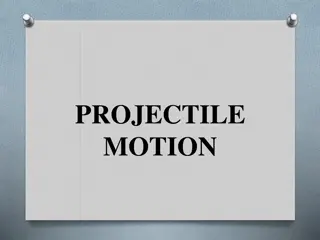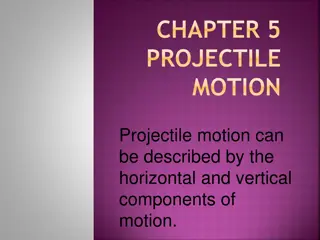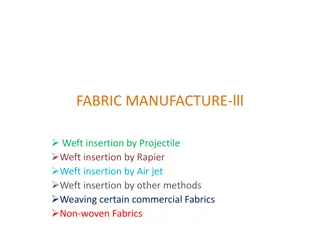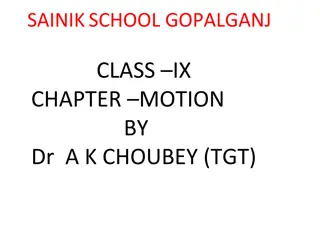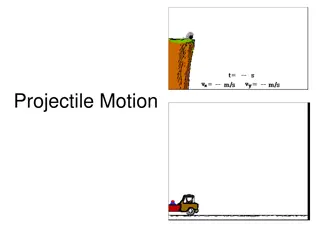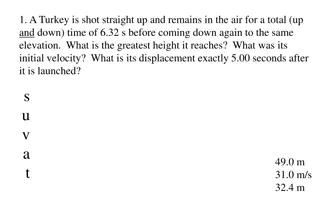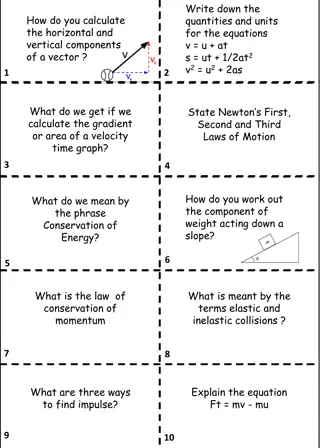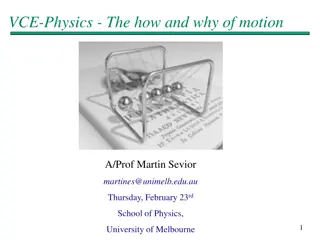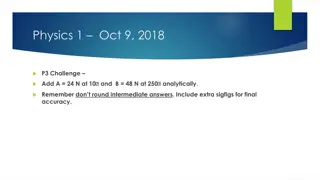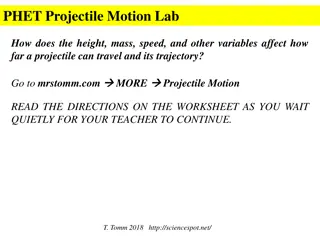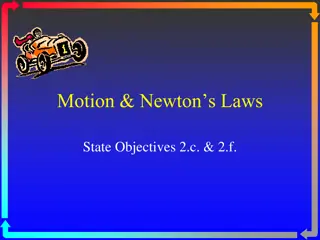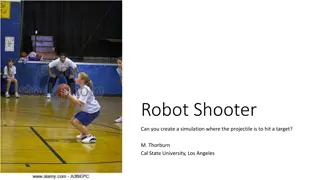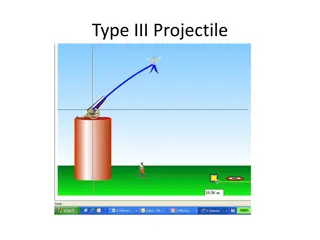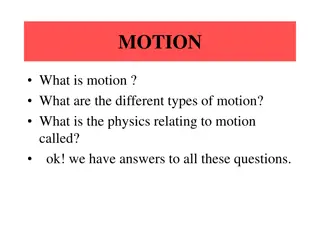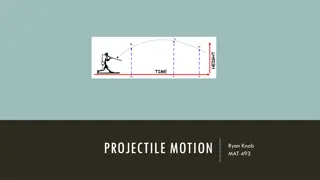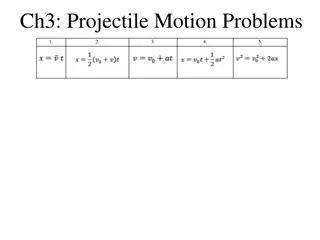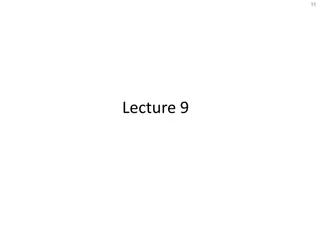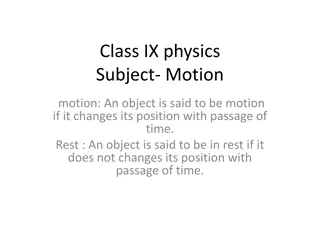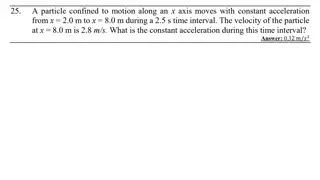Senior High School Projectile Motion Physics 2006 Overview
Explore the principles of projectile motion in high school physics through examples, equations, and analysis. Understand trajectory, total time, horizontal range, and final velocity in a frame of reference. Discover the relationship between horizontal and vertical motions and solve questions related to uniform and accelerated motion. Dive into the fundamentals of projectile motion without air resistance.
Download Presentation

Please find below an Image/Link to download the presentation.
The content on the website is provided AS IS for your information and personal use only. It may not be sold, licensed, or shared on other websites without obtaining consent from the author.If you encounter any issues during the download, it is possible that the publisher has removed the file from their server.
You are allowed to download the files provided on this website for personal or commercial use, subject to the condition that they are used lawfully. All files are the property of their respective owners.
The content on the website is provided AS IS for your information and personal use only. It may not be sold, licensed, or shared on other websites without obtaining consent from the author.
E N D
Presentation Transcript
PROJECTILE MOTION Senior High School Physics Lech Jedral 2006 Part 1. Part 1. Part 2. Visit www.worldofteaching.com For 100 s of free powerpoints
Introduction Projectile Motion: Motion through the air without a propulsion Examples:
Part 1. Motion of Objects Projected Horizontally
y v0 x
y x
y x
y x
y x
y Motion is accelerated Acceleration is constant, and downward a = g = -9.81m/s2 The horizontal (x) component of velocity is constant g = -9.81m/s2 The horizontal and vertical motions are independent of each other, but they have a common time x
ANALYSIS OF MOTION ASSUMPTIONS: x-direction (horizontal): uniform motion y-direction (vertical): accelerated motion no air resistance QUESTIONS: What is the trajectory? What is the total time of the motion? What is the horizontal range? What is the final velocity?
Frame of reference: Equations of motion: y X Y v0 Uniform m. ax = 0 Accel. m. ay = g = -9.81 m/s2 ACCL. g h VELC. vx = v0 vy = g t x DSPL. x = v0 t y = h + g t2 0
Trajectory y x = v0 t y = h + g t2 Parabola, open down h Eliminate time, t t = x/v0 y = h + g (x/v0)2 v02 > v01 v01 y = h + (g/v02) x2 y = (g/v02) x2 + h x
Total Time, t t = tf - ti y = h + g t2 final y = 0 y 0 = h + g ( t)2 ti =0 h Solve for t: t = 2h/(-g) t = 2h/(9.81ms-2) tf = t Total time of motion depends only on the initial height, h x
Horizontal Range, x x = v0 t y final y = 0, time is the total time t x = v0 t h t = 2h/(-g) x = v0 2h/(-g) Horizontal range depends on the initial height, h, and the initial velocity, v0 x x
VELOCITY vx = v0 vy = g t v v = vx2 + vy2 = v02+g2t2 tg = vy/ vx = g t / v0
FINAL VELOCITY vx = v0 t = 2h/(-g) tg = g t / v0 = -(-g) 2h/(-g) / v0 vy = g t v v = vx2 + vy2 v = v02+g2(2h /(-g)) v = v02+ 2h(-g) = - 2h(-g) / v0 is negative (below the horizontal line)
HORIZONTAL THROW - Summary h initial height, v0 initial horizontal velocity, g = -9.81m/s2 Trajectory Half -parabola, open down t = 2h/(-g) Total time Horizontal Range x = v0 2h/(-g) Final Velocity v = v02+ 2h(-g) tg = - 2h(-g) / v0
Part 2. Motion of objects projected at an angle
y vi Initial position: x = 0, y = 0 Initial velocity: vi = vi [ ] viy Velocity components: x- direction : vix = vicos y- direction : viy = visin x vix
y a = g = - 9.81m/s2 Motion is accelerated Acceleration is constant, and downward a = g = -9.81m/s2 The horizontal (x) component of velocity is constant The horizontal and vertical motions are independent of each other, but they have a common time x
ANALYSIS OF MOTION: ASSUMPTIONS x-direction (horizontal): uniform motion y-direction (vertical): accelerated motion no air resistance QUESTIONS What is the trajectory? What is the total time of the motion? What is the horizontal range? What is the maximum height? What is the final velocity?
Equations of motion: X Y Uniform motion ax = 0 Accelerated motion ay = g = -9.81 m/s2 ACCELERATION VELOCITY vx = vix= vi cos vx = vi cos vy = viy+ g t vy = vi sin + g t DISPLACEMENT x = vix t = vi t cos x = vi t cos y = h + viy t + g t2 y = vi tsin + g t2
Equations of motion: X Y Uniform motion ax = 0 Accelerated motion ay = g = -9.81 m/s2 ACCELERATION VELOCITY vx = vi cos vy = vi sin + g t DISPLACEMENT x = vi t cos y = vi tsin + g t2
Trajectory x = vi t cos y = vi tsin + g t2 Eliminate time, t Parabola, open down y t = x/(vi cos ) sin x + 2 v gx = i y 2 i 2 cos 2 cos g v v i = + 2 tan y x x 2 i 2 2 cos v y = bx + ax2 x
Total Time, t y = vi tsin + g t2 final height y = 0, after time interval t 0 = vi tsin + g ( t)2 Solve for t: x 0 = vi sin + g t 2 vi sin t = t = 0 t (-g)
Horizontal Range, x x = vi t cos y final y = 0, time is the total time t x = vi t cos 2 vi sin t = x (-g) 0 sin (2 ) = 2 sin cos x 2vi 2 sin cos (-g) vi 2 sin (2 ) (-g) x = x =
Horizontal Range, x vi 2 sin (2 ) (-g) x = (deg) sin (2 ) CONCLUSIONS: 0 0.00 Horizontal range is greatest for the throw angle of 450 15 0.50 30 0.87 45 1.00 Horizontal ranges are the same for angles and (900 ) 60 0.87 75 0.50 90 0
Trajectory and horizontal range g = + 2 tan y x x 2cos i 2 2 v 35 vi = 25 m/s 30 15 deg 30 deg 45 deg 60 deg 75 deg 25 20 15 10 5 0 0 20 40 60 80
Velocity Final speed = initial speed (conservation of energy) Impact angle = - launch angle (symmetry of parabola)
Maximum Height vy = vi sin + g t y = vi tsin + g t2 At maximum height vy = 0 0 = vi sin + g tup hmax = vi t upsin + g tup2 hmax = vi2 sin2 /(-g) + g(vi2 sin2 )/g2 vi sin (-g) tup = vi2 sin2 2(-g) hmax = tup = t/2
Projectile Motion Final Equations (0,0) initial position, vi = vi [ ] initial velocity, g = -9.81m/s2 Parabola, open down Trajectory 2 vi sin (-g) Total time t = vi 2 sin (2 ) x = Horizontal range (-g) vi2 sin2 hmax = Max height 2(-g)
PROJECTILE MOTION - SUMMARY Projectile motion is motion with a constant horizontal velocity combined with a constant vertical acceleration The projectile moves along a parabola


